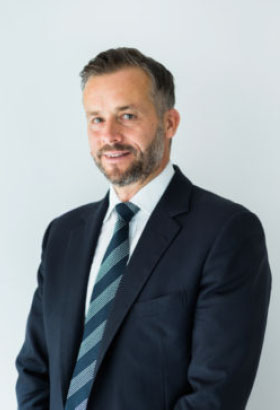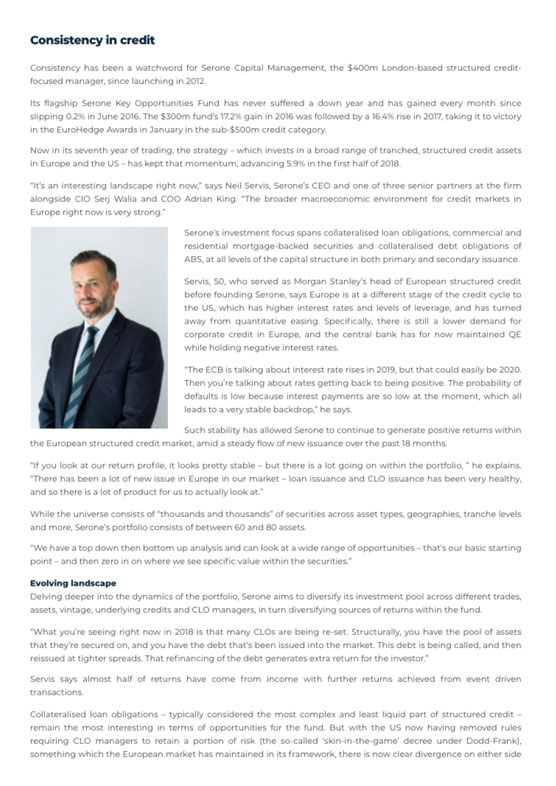EuroHedge. Serone Maintains Consistency in Credit
Consistency has been a watchword for Serone Capital Management, the $400m London-based structured credit-focused manager, since launching in 2012.
“It’s an interesting landscape right now,” says Neil Servis, Serone’s CEO and one of three senior partners at the firm alongside CIO Serj Walia and COO Adrian King. “The broader macroeconomic environment for credit markets in Europe right now is very strong.”

Serone’s investment focus spans collateralised loan obligations, commercial and residential mortgage-backed securities and collateralised debt obligations of ABS, at all levels of the capital structure in both primary and secondary issuance.
Servis, 50, who served as Morgan Stanley’s head of European structured credit before founding Serone, says Europe is at a different stage of the credit cycle to the US, which has higher interest rates and levels of leverage, and has turned away from quantitative easing. Specifically, there is still a lower demand for corporate credit in Europe, and the central bank has for now maintained QE while holding negative interest rates.
“The ECB is talking about interest rate rises in 2019, but that could easily be 2020. Then you’re talking about rates getting back to being positive. The probability of defaults is low because interest payments are so low at the moment, which all leads to a very stable backdrop,” he says.
Such stability has allowed Serone to continue to generate positive returns within the European structured credit market, amid a steady flow of new issuance over the past 18 months.
“If you look at our return profile, it looks pretty stable – but there is a lot going on within the portfolio, ” he explains. “There has been a lot of new issue in Europe in our market – loan issuance and CLO issuance has been very healthy, and so there is a lot of product for us to actually look at.”
While the universe consists of “thousands and thousands” of securities across asset types, geographies, tranche levels and more, Serone’s portfolio consists of between 60 and 80 assets.
“We have a top down then bottom up analysis and can look at a wide range of opportunities – that’s our basic starting point – and then zero in on where we see specific value within the securities.”
Evolving landscape
Delving deeper into the dynamics of the portfolio, Serone aims to diversify its investment pool across different trades, assets, vintage, underlying credits and CLO managers, in turn diversifying sources of returns within the fund.
“What you’re seeing right now in 2018 is that many CLOs are being re-set. Structurally, you have the pool of assets that they’re secured on, and you have the debt that’s been issued into the market. This debt is being called, and then reissued at tighter spreads. That refinancing of the debt generates extra return for the investor.”
Servis says almost half of returns have come from income with further returns achieved from event driven transactions.
Collateralised loan obligations – typically considered the most complex and least liquid part of structured credit – remain the most interesting in terms of opportunities for the fund. But with the US now having removed rules requiring CLO managers to retain a portion of risk (the so-called ‘skin-in-the-game’ decree under Dodd-Frank), something which the European market has maintained in its framework, there is now clear divergence on either side of the Atlantic for the first time since the crisis.
“We just worry slightly about the quality of some of the product coming out of the US,” says Servis. “Suddenly, two people can get together and issue a CLO with very low barriers to entry, so now you have to make sure that you’re more careful about some of the assets in the US.”
As issuance volumes pick up and CLO managers battle to take on new loans to put in their vehicles, some credit market participants are weighing whether this scramble might lead to weaker terms and covenants in the underlying loans being written.
One potential knock-on effect of weakened covenants may be the postponement of the default cycle, believes Anthony Robertson, CIO at Cheyne Capital. Robertson suggested this amounts to “kicking the can down the road”, heralding a more negative outcome further down the line, in an appearance at the EuroHedge Summit last month.
With roughly half of loans in Europe today now subject to rules which prohibit their transferability or assignment to another prospective buyer, that also poses challenges.
“It’s problematic for the CLO manager who is looking to pre-empt future impairment risk by offloading risk at higher valuation levels where there are no natural buyers of those loans,” said Robertson. “The only names on those ‘whitelists’ are other CLO funds who are certainly not natural buyers of an impaired asset.”
“I think people are getting slightly concerned about covenant levels in the US,” Servis says. “We hear some of the managers talking about Europe and the US, at the loan level, and there seems to be loans in the US where the covenant quality is lower than it would be in the European market.
Hedging headaches
The spike in volatility that rocked financial markets in the early months of 2018, and which impacted the mark-to-market value of many assets held in Serone’s fund, brought into sharp relief the importance of hedging the portfolio.
Though credit default swaps once offered a method of shorting CLOs and other structured credit products directly, that market has been largely shuttered following their central role during the 2008 crash. Instead, Serone uses indirect portfolio-level hedges, such as shorting credit indices and equity indices, rather than hedging assets directly.
“You hear a lot of noise made around credit default swaps out there in the market, and with the regulators; whether they’re a good financial instrument or a bad financial instrument,” Servis says. He does not rule out a future reopening of the CDS market, adding that the catalyst would simply be a growth in demand.
“We are in the camp of CDS being a necessary financial instrument. We would like to have that tool to protect our portfolio and protect our investors. It’s something we’ve traded in and invested in a lot in the past. Regulators seem to think that shorting doesn’t create any value for anyone, but we would see it as creating liquidity in the market.”
This perspective is further underlined by recent forecasts that predict more frequent bouts of volatility in markets this year. Hedge fund industry figures are vocal about the rising opportunities for short sellers and active managers, with the focus shifting back to active strategies and away from passive funds.
“If suddenly everybody was selling their assets because they can’t hedge them, there is an argument that this increases volatility. If you have to sell an asset and then look to buy it back, you could argue that creates more volatility than if you were able to hedge the positions you have. At Serone we are constantly looking and analysing different types of instruments for their hedging capabilities that we can deploy within our hedging strategy.”
The fund is set to remain fairly stable in its current positioning in terms of asset mix for the remainder of 2018. Despite much of the fund’s investment universe – CLOs, ABS and many other acronym-heavy assets – being indelibly linked to the 2008 global financial crisis in the minds of many, Servis remains optimistic its ability to generate strong returns for investors looking forward.
“We see the most value in the European corporate space is right now. On the US side, we’ve reduced our exposure there over the last few years. But we do follow the US closely, and the US is a bigger market. It’s roughly four times bigger than Europe, more transparent and for the most part easier to access than Europe.”
Pulling power
Observing the disenchantment in equities due to crowded trades, with yield-parched investors still on the lookout for risk-adjusted returns in the present environment, Servis points to the Key Opportunities Fund’s six-year track record as a major pulling point for potential new clients.
The management team at Serone sees resurgent interest in credit products. Some credit focused-hedge funds are well-positioned and benefit from timing the cycle, offering geographical diversification and more exposure to Europe.
“Admittedly, there are still those investors who bracket ‘structured credit’ under ‘subprime’. We don’t have any subprime exposure in the portfolio, but people associate it with that,” Servis notes.
“Sometimes I run into investors that had a lot of subprime exposure in 2008. Either they just bracket structured credit with that, or they still carry the scars and don’t want to get involved. The crisis was more than ten years ago, and you now have data to show that actually the vast majority of CLOs performed well and returned principal to investors.”
Aside from Serone Key Opportunities, the remaining quarter of the firm’s assets are spread across a handful of managed accounts and bespoke products.
“In the main fund, the portfolio consists of our best ideas across markets. But some investors may want a slightly different portfolio mix to the main fund; it may be that they want to access a different part of the market – whether it’s return profile, or liquidity profile,” Servis explains.
Turning to fees, and the continued wrangle between managers and investors, Servis says his firm – which has a 1.5% and 20% fee framework – has not seen the fierce investor push-back encountered by managers running other strategy types.
“I think when people start doing their work with us, they realise that this is a high cost resource business,” he says. “It is not the proverbial twomen-and-a-Bloomberg-terminal set-up – we do quite a lot of work on the assets we buy. You hear about other strategies and managers getting hit on fees – but that’s not been the case with us.”
He continues: “I was asked by one investor directly – could you ever do an artificial intelligence-strategy in what you currently do? My answer is currently no. Although AI could be used to enhance screening, optimisation and risk management, I feel that while some of what we do is mathematical and statistical, so much of what we do in credit is judgement, because it’s a very inefficient market.
“There are CTAs, which are massive and have very, very low costs. But then there’s the other end of the spectrum, where we are. It is a complex product, and with much more value-add from the manager. And unless you’ve been working in the market in these particular assets for many years like we have, then just coming into it and trying to do it yourself is always going to be very, very tough.”
Published
25 July 2018


